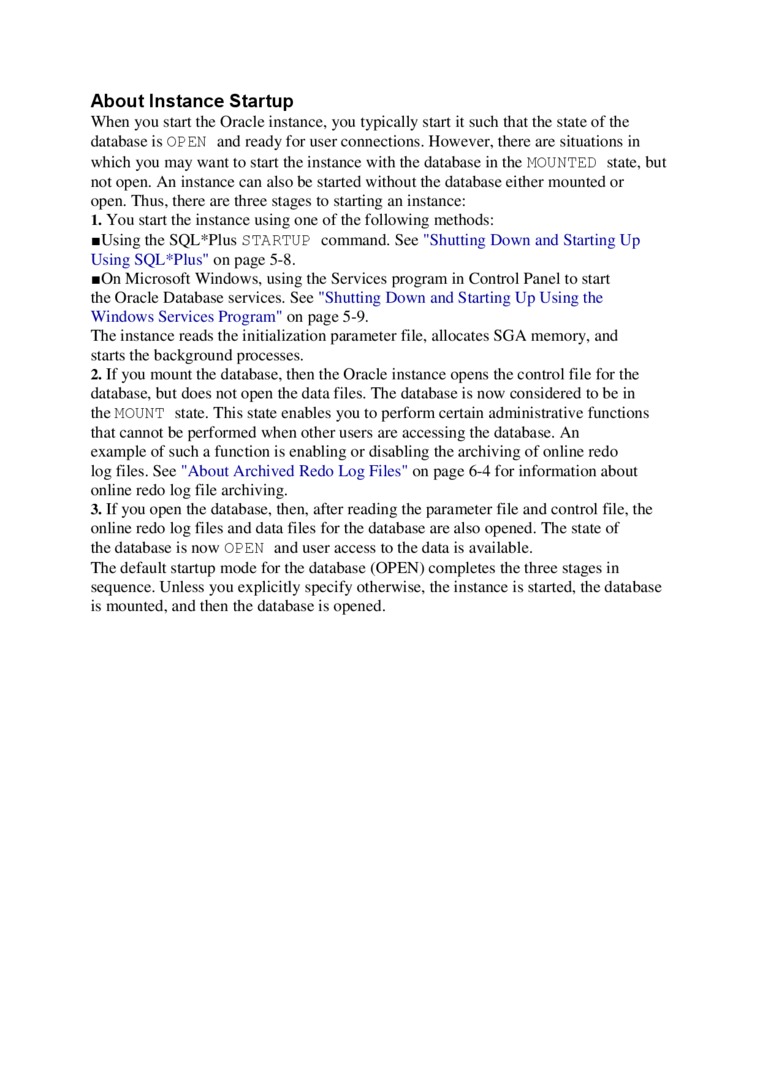79669

About Instance Startup
Whcn you start thc Oracle instance, you typically start it such that the State of the database is OPEN and ready for user connections. However, there arc situations in which you may want to start the instance with the database in the MOUNTED State, but not open. An instance can also be startcd without the database cither mounted or open. Thus, there are thrce stages to starting an instance:
1. You start the instance using one of the following methods:
■Using the SQL*Plus STARTUP command. See "Shutting Down and Starting Up Using SQL*Plus" on pagc 5-8.
■On Microsoft Windows, using thc Scrviccs program in Control Panel to start thc Oracle Database scrviccs. See "Shutting Down and Starting Up Using thc Windows Scrviccs Program" on page 5-9.
The instance reads the initialization parametcr file, allocatcs SGA mcmory, and starts the background processes.
2. If you mount the database, then the Oracle instance opens the control file for the database, but does not open the data files. The database is now considered to be in the MOUNT State. This State enables you to perform ccrtain administrative functions that cannot be performcd when othcr users are accessing the database. An cxamplc of such a function is cnabling or disabling the archiving of online redo
log files. See "About Archived Redo Log Files" on page 6-4 for information about online redo log file archiving.
3. If you open the database, then, after reading the parameter file and control file, the online redo log files and data files for the database are also opened. The State of
thc database is now OPEN and user acccss to the data is availablc.
The default startup modę for the database (OPEN) completes the three stages in sequence. Unless you explicitly specify otherwise, the instance is started, the database is mounted, and then the database is opened.
Wyszukiwarka
Podobne podstrony:
About Undo Data Whcn a transaction modifies data, Oracle Database copies the original data before mo
MySQL Proxy Command Options To start MySQL Proxy, you can run it directly from the command linę: she
About Administration Privileges for Startup and Shutdown To start or shut down thc Oracle instancc,
About Instance Shutdown Instance shutdown is thc reverse of instance startup. When you shut down the
Shutting Down and Starting Up Using SQL*Plus You can shut down and start thc Oracle instance using S
About Memory Management Memory managcmcnt involves maintaining optimal sizes for thc Oracle instancc
Understanding the SQL Developer User Interface Whcn you start SQL Dcvclopcr. thc SQL Dcvelopcr windo
Creating and Managing a Databasewith DBCA Unlcss you spccified that only thc Oracle Databasc softwar
62441 vibro 09 IN THE EVENING Pul aaide nil thc caroa of Ihc day whcn you nit down to dinner ul niff
About Rohde&Schwarz Service you can rely on l Worldwide Long-ierm dependability Rohde&Schwar
rosicrucians Rosicrucians The truć Roikmckim do not (Kbertte, ond their powen are rnondite indeed...
scbb09 You are strongly adviscd to lcarn the namcs of at lcast thc main surfacc muscles of thc body
rqe Start hercHelp!!! The State animal has run off!You can help... draw a path through the maże to h
więcej podobnych podstron